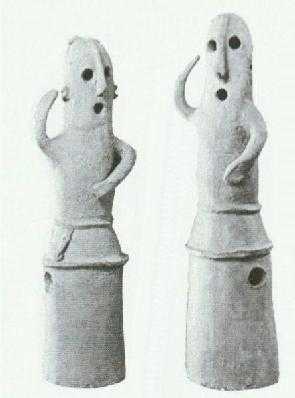はにわと文化 - Haniwa and Culture
In the Kofun Era (300 AD – 710 AD), we must mention that Kofun Era pottery was harder than Yayoi Era (300 BC – 300 AD) pottery. It was also wheel-turned. In these tombs were found the first of the HANIWA statues. These images were also of clay and both male and female with garments, jewelry and hair styles, carefully shown. Animal statues were also found, especially horses.
像に関するエッセイの続きです。古墳時代に目を移すと、古墳時代の焼き物は弥生時代(紀元前300年〜紀元300年)のものと比べて丈夫にできていました。また、古墳時代にはろくろも使用されました。この時代の古墳から、最初のはにわが見つかっています。はにわは粘土で作られた男女の像で、当時人々が身に付けていた衣装、宝石、髪型などが精巧に表現されています。また、動物を模したはにわ、特に馬のはにわが出土しています。
Among many other ancient artifacts of this period, one deer statue can be seen in the Fudoki no Oka Museum in Matsue. Showing the impact of a new invasion of culture, the HANIWA mentioned above as representing men and women had some colors applied, especially red. The dress is a close copy of that of the Mongols or Chinese of that period. It is also the dress shown on the statues of Okuninushi at Izumo Taisha. Weapons found in the tombs were most often similar to those of China or northern Asia. The humming-arrow, which is mentioned in the story of Okuninushi no Mikoto of Izumo Taisha, has also been found and is told of in stories of the Mongol people. Apparently, it was used to draw the attention of soldiers to a specific target, or as a signal arrow. I have read historical legends of such a use for it.
また松江市にある風土記の丘資料館では、この時代の多くの遺品に混じって、鹿をかたどったはにわを見ることができます。新しい文化の影響を示す男女のはにわには、色を施したもの、特に赤を使用したものが多くあります。さらに、それらのはにわが身に付けている衣装は、当時モンゴルや中国に住んでいた人たちが着用していたものによく似ています。同じような衣装は、出雲大社にあるオオクニヌシノミコトの像にも見られます。 古墳から発見された、古代人が使用していた武器も、中国やアジア北部で見つかったものによく似ています。オオクニヌシノミコトの物語に出てくるかぶら矢も見つかっていますが、同じ物はモンゴルの伝説にも登場します。かぶら矢は、兵士の注意を特定の目標に向けさせたり、信号として使われたようです。以前に読んだ歴史物語でも、そのように使われていました。
It is felt that the HANIWA were used to protect the dead. This practice was used in China as well, but in much greater sizes and numbers. Other cultures had such customs. Perhaps someday, I will have a chance to visit those burial sites.
はにわは、死者を守る目的で使用していたと思われます。この習慣は中国でも行われましたが、中国の俑は日本のはにわよりずっと大きく、数も多かったようです。ほかの文化にも、同じような習慣があります。 いつか、機会があればはにわが埋められた場所を訪れてみたいと思います。
In Japan, another significant item found in tombs, is the Curved Jewel. I have talked about that item many times before, but you may be interested to know that they have been found in Stone Age sites in Japan and were made of horn, bone or stone. None of them were made of teeth or claws! I still believe they symbolize fertility.
日本では、勾玉も古墳で見つかる重要な遺物です。勾玉についてはこれまで何度も触れてきましたが、おもしろいことに石器時代の遺跡からも出土しており、動物の角や骨、石で作られています。歯や爪でできたものはありませんでした。やはり、多産を象徴しているものだと私は思います。
